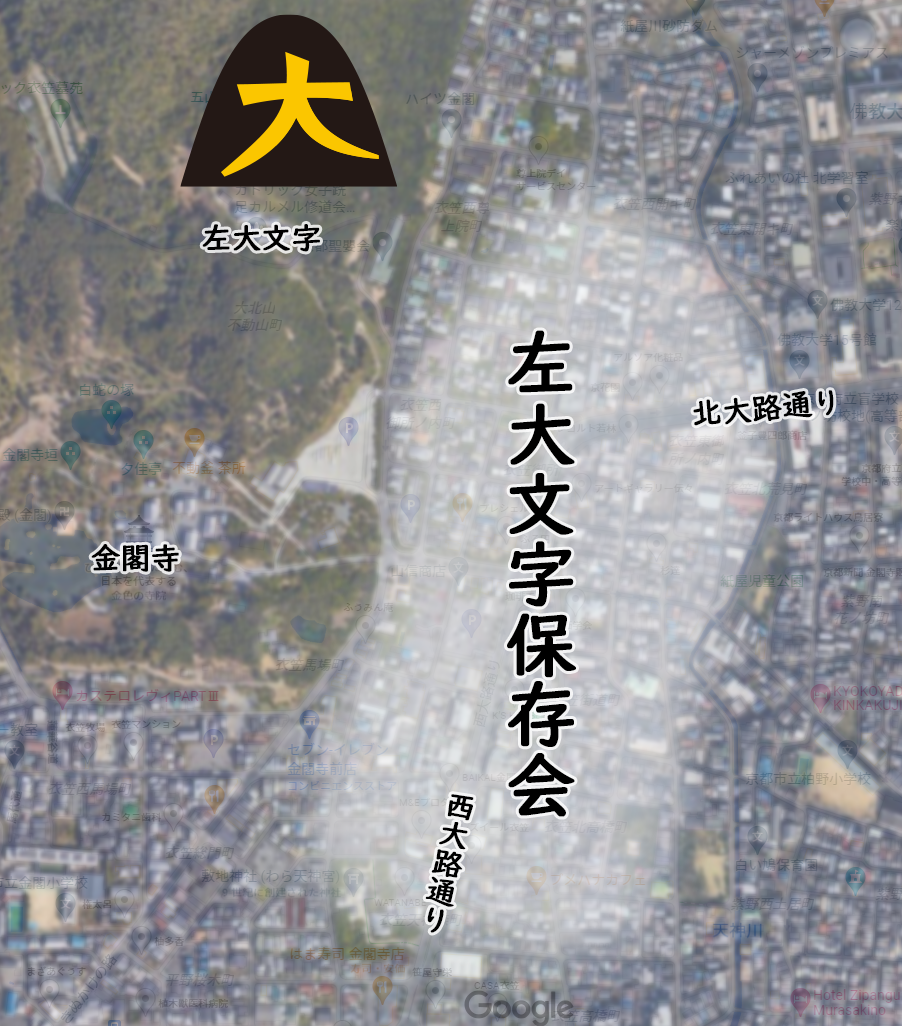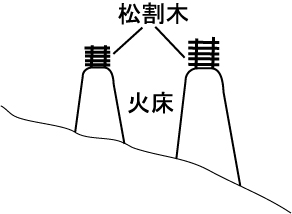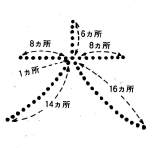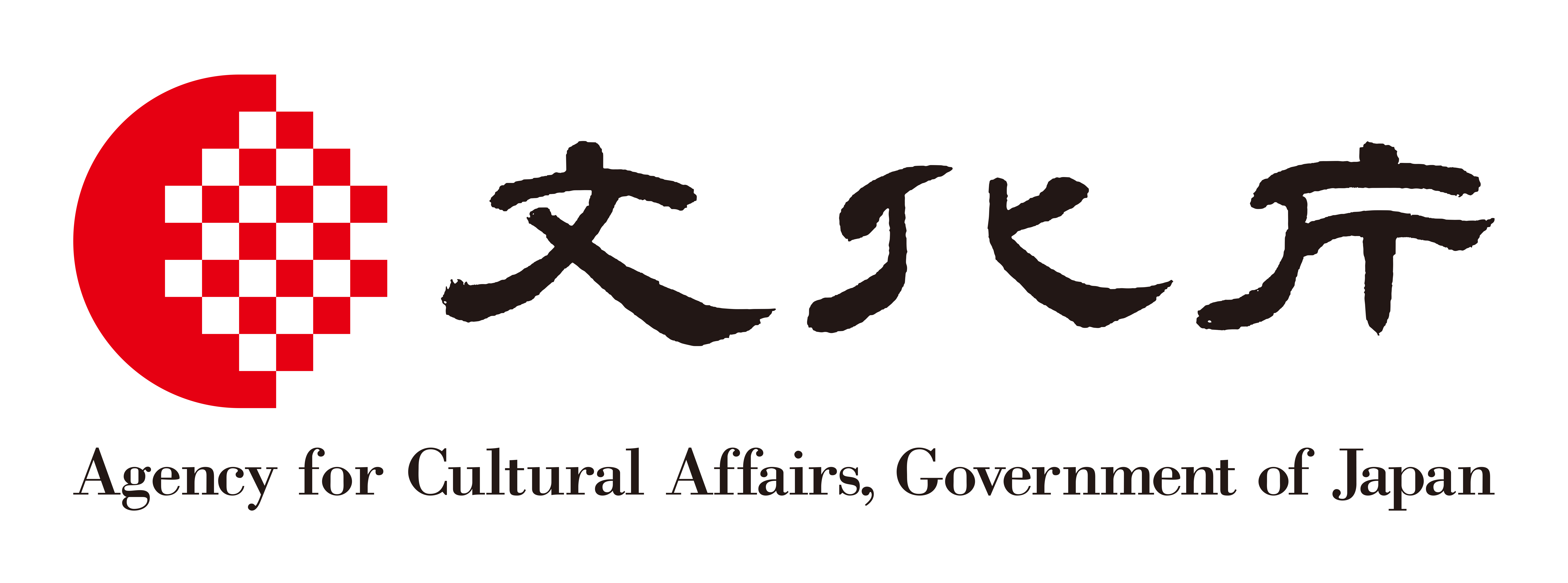

There is no folklore on the origin. Here we introduce some of the historical statements.
In the diary of a court noble of Edo period, Ozuki Tadatoshi (1600-1663)’s “Tadatoshi Sukune’s Diary”, there is the statement dated July 16, Keian 2 (1649):
Going up to the gate, I saw the lights of the towns people. Nishiyama Daimonji, Fune (Boat),, Higashiyama Daimonji-all Bonfires were beautiful.
This shows that there were “Daimonji” Bonfires, on Nishiyama and Higashiyama, one each.at that time. The “gate” mentioned here is Mt. Hiei; hence “ Higashiyama Daimonji” is the present Daimonji Bonfire; however, “Nishiyama” is not the present one, but the Hidari Daimonji Bonfire on Ohkitayama. This is proved by the record in the diary “Kakumeiki” by Monk Horin Josho(1593~1668) who was the chief priest of Rokuonji (Kinkakuji) at the same time, mentioning the Bonfire lit on the Rokuonji hill.

In spite of the information of this temple’s penance lanterns lighting,
I did not go up the hill. (July 16, 1646 Shoho 3).
This evening, this temple’s penance lanterns lighting, like every year (July 16, 1649 Keio 2).
Like every year we prepared for Daimonji Bonfire on the hill ( July 16, 1650 Keio 3).
Daimonji-yama on which Hidari Daimonji Bonfire is lit is at Kagamiishi-cho, Ohkitayama, Kita-ku, Kyoto City. Old Ohkitayama -mura(village) includes Rokuonji Monzencho, and closely related to Rokuonji. Therefore the above mentioned “this temple hill” must be Daimonji hill.
Incidentally in the pictorial map “Rakugaizu Byobu” drawn around 1660 (Manji 3), four Bonfires, Higashiyama Daimonji, Myoho, Funagata and Toriigata are depicted, but not Hidari Daimonji. What this means, waits for further research, together with others.

For two days , on August 15 and 16, homa stick offering ( for prayer for memorial service for ancestors and sound health) is accepted at the front gate of Kinkakuji and at the local family temple Hoonji (Kinugasa Gaido-cho, Kita-ward).
Around 7 p.m. the leading Bonfires are lit in front of the 24 houses along Hoonji Monzen-doori , leading the ancesters’ spirits to the family temple. At the temple, the lighting stand of the main fire is placed, where homa sticks are burnt to console them. With that fire, the main fire and 60 hand torches are lit. They are carried to the top of the hill and the Bonfire on the hill is lit.


Hidari Daimonji Hozonkai (Hidari Daimonji Bonfire Conservation Association)
Members: ca.65
The members used to be limited to the male-line men of ancient and respectable families, but now female-line men can participate.


As the Hidari Daimonji hill is very rocky and cannot be levelled to make the fireplace. They used to use beacon fires in iron baskets. Today 53 concrete built fireplaces on the hillside are used, their height vary from 30 cm to 3 meters, depending on the incline of the slope.



300 split pine firewood piled up in 井 shapes about 1 meter high are used,
with 5,000 homa sticks inside.

On 17th every month, women in the area around Hoonji gather in the Kannondo Hall of Hoonji and chant pilgrim hymns. Those hymns are Buddhist hymns chanted by lay Buddhists on pilgrims and services. They sing, taking rhythms with a bell in the left hand and a gong in the right, sounding the gong with a wooden bell-hammer. Formerly different melodies were locally handed down, but in 1921 (Taisho 10) Yamazaki Tikumatsu in Kagawa organized Yamato style, free from particular religious groups. ( Shinhori 2008). Kitayama Amako still keeps the traditional melody, despite that many religious groups have organized their own sects, handing down their own melodies.
As to the origin of the hymns, there are several theories. “Chikkyo Seiji” by Koshi Eho (1414~1469), a Zen priest of Muromachi period, and “Ten’in Goiroku” by Ten’in Ryutaku (1422~1500) say that Emperor Kazan (968~1008) started the Saigoku Junrei, West Japan Pilgrimage (Yoshii Toshiyuki 1985) and Emperor Kazan’s poems are said to have turned to pilgrims’ hymns for the 33 Saigoku pilgrim places. From these Emperor Kazan is considered to be the origin of these hymns.
Nor is clear the origin of Kitayama Ama Ko. However, with the imperial tomb of Emperor Kazan, Kamiyagawa hotori no Misasagi at this place, Ohkitayama, the Ama Ko is considered to have been inherited by the local people here.
References:
Shinhori Kanno “The Process of Formation of Yamato Style Pilgrim Hymns”, Toyo Ongaku Kenkyu vol 73, 2008
Yoshii Toshiyuki “Formation of Saigoku Junrei (Pilgrimage) and Organization of Pilgrimage Temples” (Mano Toshikazu Ed. Series Pilgrimages of Japan 1 Pilgrimages of Principal Buddhist Images Yuhikaku 1996)

Q: Can we go up Daimonji on the Bonfire day?
A: Climbing the hill is not allowed throughout the year.
Q: Do you accept volunteers for the service?
A: No, we do not accept volunteers.
Q: How can we offer homa sticks?
A: We accept them as follows:
August 159 a.m. to 3 p.m.
Aygust 167 a.m. to 2 p.m.both days till they are sold out.
Q: Is the hymn chanting open to the public?
A: Though we do not prepare special seats for visitors,, if you come to Hoonji around 9:30 p.m. on August 16, you can listen to them.

本事業は,令和2年度文化芸術振興費補助金(地域文化財総合活用推進事業(地域無形文化遺産継承のための新しい生活様式支援事業))の助成を受けて令和3年度に実施する「コロナ禍における無形民俗文化財のための継承・保存・活性化事業」の一部です。
※当ホームページに掲載するすべての写真につきまして、転載・複製を禁止します。
Copyright © Kyoto Gozan Okuribi Rengoukai All Right Reserved.
















